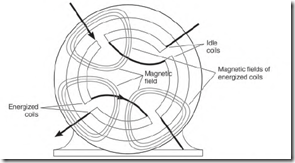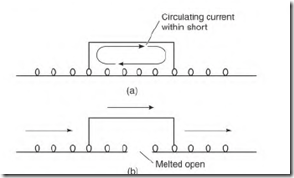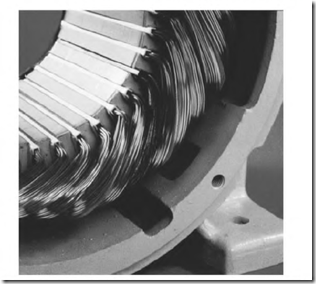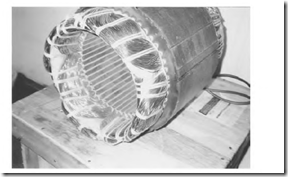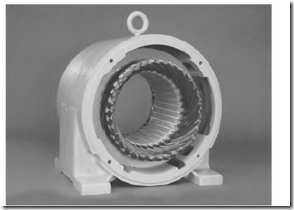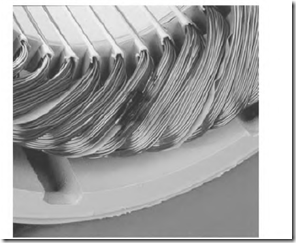An explanation of the unmarked lead test involves magnetic circuits and transformer theory. Figure 6.28 shows a single-phase magnetic circuit containing four poles.
When half the poles are energized with intermittent DC, two more poles are created in the motor’s iron core. The magnetic lines of force of these poles will cut the conductors of the idle poles as shown.
Power is transformed into the idle pole’s coils, making it a transformer secondary. An analog DC voltmeter (attached to the idle pole’s leads) will show a deflection. (A digital voltmeter reacts too fast and won’t show the correct polarity.)
The deflection in the idle half of the winding is strong, because it’s in the same magnetic circuit (or angle) as the half that’s intermittently energized.
FIGURE 6.28 The magnetic circuit that develops in the stator iron (when half of a phase is energized). The magnetic fields of the energized coils cut the wires of the idle coils, transforming a low voltage into them.
6
In a three-phase stator, two phases are energized. The third phase is not in the magnetic circuit of the energized phases, and has very little voltage transformed into it.
Typical Winding Problems
It’s very important to accurately identify problems that require a motor’s removal and replacement. Winding problems that are identified should be documented. A history of the plant’s motor problems (on computer software) will point out problem areas that can be improved, or even eliminated. These winding problems may be found in a three-phase motor:
• Shorted turns
• Ground (winding shorted to frame)
• Phase-to-phase short
• Open winding
• Burned windings from operating on single phase
• Submerged motor
• Assorted rotor problems
These problems require replacing or rewinding the motor.
Shorted Turns
A short is a common winding breakdown, and it requires rewinding or replacing the motor. Shorted turns are caused by nicked coil wire, highvoltage spikes, conductive contaminants, overheated winding, aged insulation, and loose, vibrating coil wires.
As explained under “Inductive Reactance” in Chapter 3, most of the resistance to current flow in an AC motor is furnished by inductive reactance. The resistance of the wire in a complete phase is a very small percentage of the motor’s total impedance (resistance plus inductive reactance). Inductive reactance makes each turn very significant in the motor’s ampere demand. Each turn supplies much more inductive reactance than resistance.
A short forms when one or more turns of a coil are bypassed because of an insulation breakdown between wires. The resistance that the shorted turns develop is eliminated from its phase winding, resulting in increased amperes.
When there are a few shorted turns in one of the three phases, a closedloop circuit is formed by the turns within the short. As the motor runs, lines of force (from AC current flow) cut the wires in the closed-loop circuit. A high circulating current is transformed into the loop (Fig. 6.29a). Power consumed by the circulating current increases the amperes of the faulty phase, making it easy to identify the problem.
Circulating current in the closed loop often melts the circuit open. When this happens, the circulating current and the turns within the closed loop are eliminated (Fig. 6.29b). Only the resistance of the wire (turns) within the closed loop is now eliminated from the phase winding. Without the ampere demand of the circulating current, the difference lessens between the amperes of the faulty phase and those of the normal phases. A very small difference in resistance is all that is needed to identify the faulty phase. (The rotor should be turned during this test to eliminate its effect.)
Shorted turns in any AC winding are usually visible. They become charred quickly from the high circulating current that is transformed into them (Fig. 6.30).
Ground
When a motor is “grounded, ” the winding is shorted either to the laminated core or to the motor’s frame. The problem is usually found in a slot, where the slot insulation has broken down. Water is the most common cause of a grounded winding. A solid ground requires rewinding or replacing the motor.
FIGURE 6.29 (a) Transfoymed current flow in the turns within a sh01ted coil (closed loop) raises the amperes of the phase. (b) Closed loop melted open.
FIGURE 6.30 A sh01ted coil. EASA.
Some causes of slot insulation breakdowns are overheating, conducting contaminants, lightning, age, pressure of a tight coil fit, hot spots caused by lamination damage (from a previous winding failure), and excessive coil movement. Excessive coil movement is often caused by thermal growth and/ or coil twisting torque, brought on by reversing (plugging) or a momentary power interruption.
Phase-to-Phase Short
A phase-to-phase short is caused by insulation breakdown at the coil ends or in the slots. This type of fault requires rewinding or replacing the motor.
Voltage between phases can be very high. When a short occurs, a large amount of winding is bypassed. Both phase windings are usually melted open, so the problem is easily detected.
Among the causes of interphase breakdown are contaminants, tight fit (in the slot), age, mechanical damage, and high-voltage spikes.
Coils that form the poles for each phase are placed on top of each other in all three-phase motors. Figure 6.31 is a concentric-type winding. The coils don’t share the slots with other poles in some concentric-type windings.
Figure 6.32 is the lap-winding type. The ends of the coils are nested within each other and have phase insulation between the poles. The coils usually share the slots with other poles. Insulation also separates the coils of each phase in the slots.
Some motors (up to 5 horsepower) are wound with no insulation separating the phases. Phase-to-phase insulation is important because there is a line voltage potential between phases regardless of a motor’s horsepower.
Figure 6.33 is an end coil phase-to-phase short.
A phase-to-phase short occurs in the slot more often than at the coil ends. When a breakdown occurs in the slot, copper usually melts and fuses to the slot laminations. This copper has to be ground out and removed before the motor is rewound, or it becomes a hot spot and deteriorates the new insulation.
FIGURE 6.31 Windings of a concentric-wound stator. Electrom Instruments.
FIGURE 6.32 Windings of a lap-wound stator. EASA.
FIGURE 6.33 Winding with a phase-to-phase short. EASA.
Open Winding
A common cause of an open winding is undersized lead lugs. (See “Motor Lead Connecting Lugs,” later in the chapter.) Charred connections in the motor’s connection box are a sure indication of this problem.
Open windings are also caused by shorted turns, phase-to-phase shorts, ground-to-frame shorts, faulty internal coil-to-coil connections, severe overloads, and physically damaged coils. These faults require rewinding or replacing the motor.
An open winding will show several different symptoms (depending on the motor’s internal connection). A wye-connected motor with an open winding will test differently from a delta-connected motor.
An open single-circuit winding will be “single-phased. ” Its power will drop to about half, and the motor won’t start.
If the motor’s internal connection is multicircuit, it will start but will have reduced power. An open circuit will cause the magnetic circuit to be unbalanced. Under normal load the motor will run more slowly and will overheat. A microhmmeter is used to identify this problem.
A motor with a high number of parallel circuits, that is, four and eight wye, will show less power loss when one circuit is open. Multiparallel circuit connections are used in motors above 5 horsepower.
The windings of a severely overloaded motor (operating on 250 volts) usually become completely charred before an open winding occurs. An overloaded motor operating on 440 volts, however, often will have no sign of burned wires before its windings melt open. In either case, the overload protection isn’t working, and the motor should be rewound or replaced.
